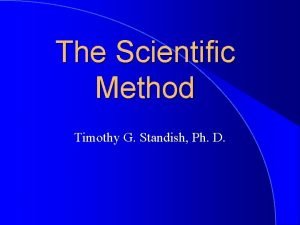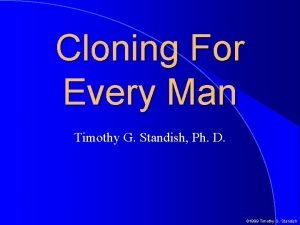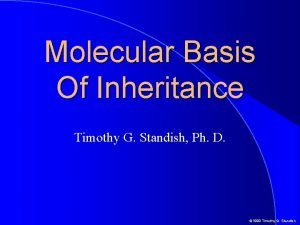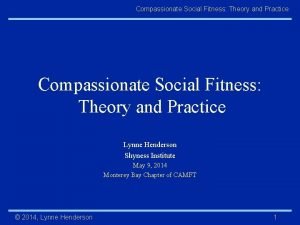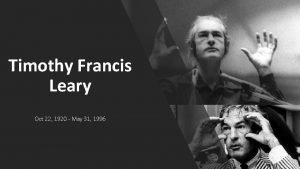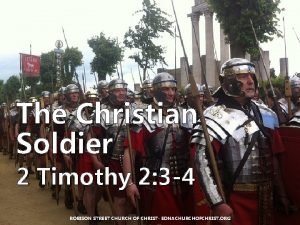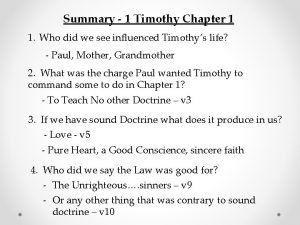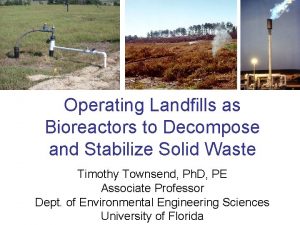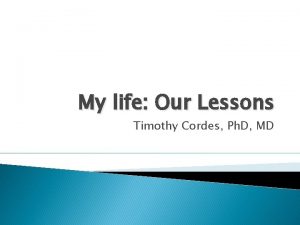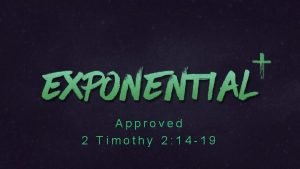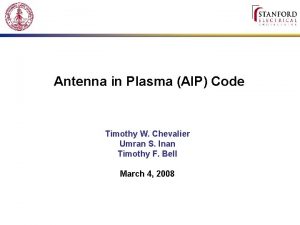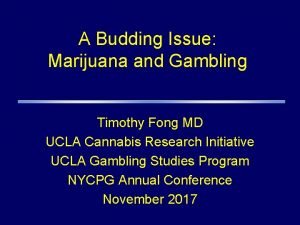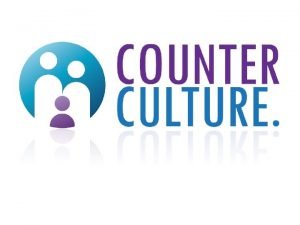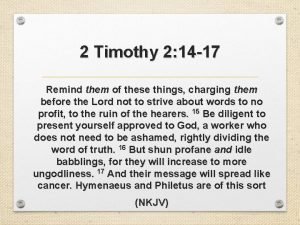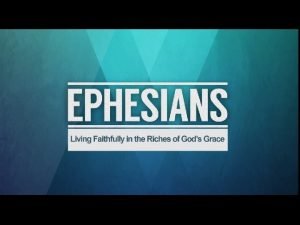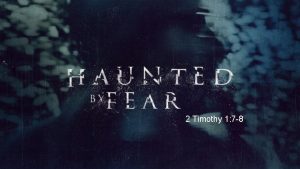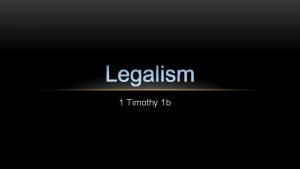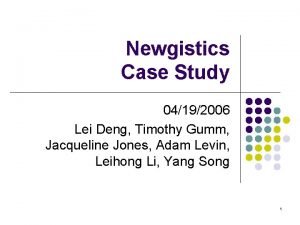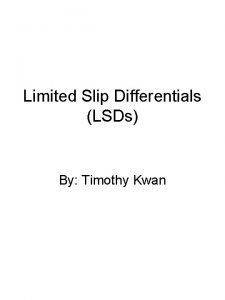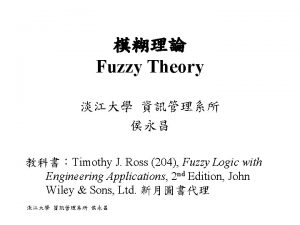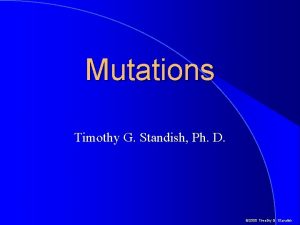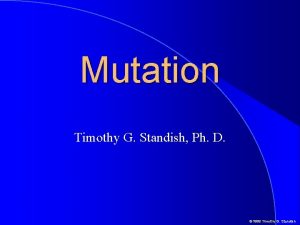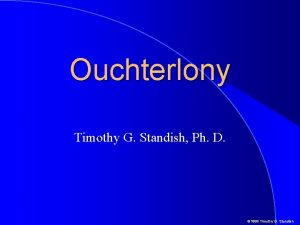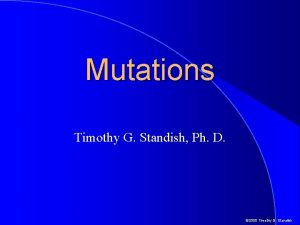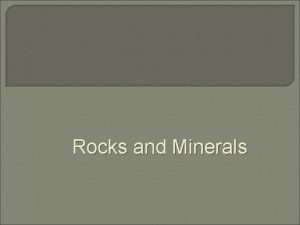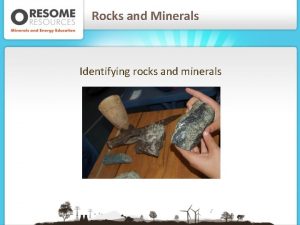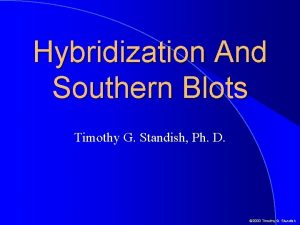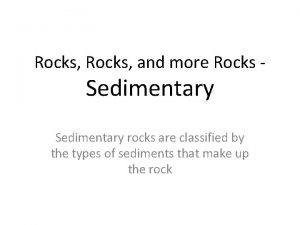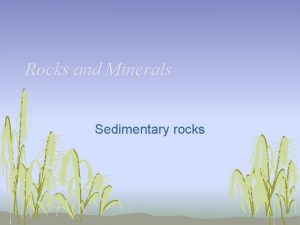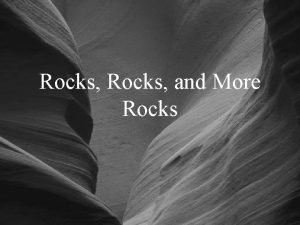Evolution Fitness and Rocks Timothy G Standish Ph

























































- Slides: 57

Evolution Fitness and Rocks Timothy G. Standish, Ph. D. © 2000 Timothy G. Standish

Evolution At least three distinct meanings: �Change over time - The fact of evolution �Natural selection - The theory of evolution �No Creator/God - The belief all organisms descended from a single common ancestor produced by “natural” events © 2000 Timothy G. Standish

� Linnaeus Before Darwin Cont. 1707 -1778 - Swedish physician and botanist – Sought to classify, or organize nature – The father of taxonomy or systematics – “Deus creavit, Linnaeus disposuit” (God creates, Linnaeus arranges) � Lamarck 1809 1744 -1829 - Published his theory of evolution in – Proposed that organisms responded to “sentiments interieurs” (felt needs) by evolving � Mathus 1766 -1834 - Proposed the utterly dismal theorum: – All populations of organisms grow until resources are completely utilized so that each individual lives at the razor’s edge of existence © 2000 Timothy G. Standish

� Cuvier Before Darwin, Cont. 1769 -1832 - Father of Paleontology, the study of fossils – Believed fossils were a record of life over time – Interpreted the fossil record in the context of catastrophism where strata in the rocks represent catastrophic events � James Hutton - Scottish geologist who, in 1795, proposed theory of gradualism – Gradualism - Geological strata were laid down over a long period of time – Gradualism is a logical outgrowth of uniformitarianism, the belief that the way things are now is the same as they were in the past. As mountains are eroding slowly now and basins are filling gradually, it follows that if the slow rate occurred in the past, laying down the amount of sedimentary rock we now see must have taken a long time. © 2000 Timothy G. Standish

Charles Darwin (1809 -1882) � As a theology major at Cambridge University, Darwin was taught a variation of the Greek view of reality � Was invited to travel around the world on the HMS Beagle surveying plant and animal life in the southern hemisphere � Compared theory he had been taught with reality and could not reconcile the two � Proposed his theory of natural selection in The Origin of Species published in 1859 © 2000 Timothy G. Standish

The Voyage Of The Beagle England Cape Verde Islands Tahiti Galapagos Islands South America Cocos Islands Rio de Janeiro Falkland Islands Mauritius Australia Sydney New Zealand The object of the expedition was to complete the survey of Patagonia and Tierra del Fuego. . . to survey the shores of Chile, Peru, and some islands in the Pacific-and to carry a chain of chronometrical measurements round the World. Charles Darwin in The Voyage of The Beagle © 2000 Timothy G. Standish

� The Logic Of Darwin fossils in South America were different from the animals that lived there now, but some seemed to be related in some way � If fossils were a record of the past (Cuvier) then there must have been change (evolution) between the past an now � Change is happening slowly; thus to get change must have taken a long time (uniformitarianism) � The rock strata took a long time to form (Hutton gradualism) thus lots of time is available for evolution � Organisms evolved over long periods of time © 2000 Timothy G. Standish

The Mechanism Of Evolution � Darwin was not the first to propose evolution, Lamarck and others had done it before him � Darwin’s real contribution was a credible mechanism for evolution - Natural Selection � Natural selection is based on two points: 1 The reproductive capacity of organisms exceeds the carrying capacity of the environment (Malthus) 2 Variation in organisms makes survival a nonrandom event - Some variants are more likely to survive in a given environment l Of the excess products of organisms reproductive capacity the most fit survive - Survival of the fittest © 2000 Timothy G. Standish

Lamarck and Darwin “Lastly, you refer repeatedly to my view as a modification of Lamarck's doctrine of development and progression. If this is your deliberate opinion there is nothing to be said, but it does not seem so to me. Plato, Buffon, my grandfather before Lamarck, and others, propounded the ‘obvious’ view that if species were not created separately they must have descended from other species, and I can see nothing else in common between the Origin and Lamarck. ” Darwin C. , letter to Charles Lyell, 12 March 1863, in Darwin F. , ed. , "The Life of Charles Darwin, " [1902], Senate: London, 1995, reprint, p 256. Emphasis in original © 2000 Timothy G. Standish

Naturalism �Naturalism - The belief that all phenomena can be explained in a rational way in terms of natural causes without invoking the supernatural �Because Darwin proposed a natural cause (natural selection) for the origin of organisms, his theory is considered more scientific than religious accounts of origins which invoke the supernatural © 2000 Timothy G. Standish

Evidence For Evolution � Biogeography - The geographical distribution of organisms reflects their origin and isolation from other species � Fossil Record - The fossil record contains missing links between present species and their ancestors. . . sort of. . . maybe � Comparative Anatomy - Homologous (similar) structures must have evolved from the same ancestral structure. . . Except when we don’t think two organisms shared a common ancestor with that structure. � Molecular Biology - More or less the same idea as comparative anatomy - Similar genetic information indicates common origin � Comparative Embryology - Similar organisms go through similar development © 2000 Timothy G. Standish

� "According Embryology? to Darwin, it was the similarity of embryos _in their earliest stages_ that provided the evidence for common descent. The actual pattern--early differences followed by similarities, then differences again--is quite unexpected in the context of Darwinian evolution. Instead of providing support for Darwin's theory, the embryological evidence present it with a paradox" � Jonathan Wells. 2000. Icons of Evolution: Science or myth? Regnery Publishing, Inc. Washington, DC. p 99. Fish Tortoise Hog Rabbit Salamander Chick Calf Human Haeckel’s embryo drawings Photos of real embryos by M. Richardson zygote. swarthmore. edu/evo 5. html © 2000 Timothy G. Standish

Missing Links and the Fossil Record "But just in proportion as this process of extermination has acted on an enormous scale, so must the number of intermediate varieties, which have formerly existed, be truly enormous. Why then is not every geological formation and every stratum full of such intermediate links? Geology assuredly does not reveal any such finely graduated organic chain; and this, perhaps, is the most obvious and serious objection which can be urged against theory. The explanation lies, as I believe, in the extreme imperfection of the geological record. ” Darwin C. R. 1872. The Origin of Species by Means of Natural Selection. “Ancient rocks clearly preserve less information, on average, than more recent rocks. However, if scaled to the stratigraphic level of the stage and the taxonomic level of the family, the past 540 million years of the fossil record provide uniformly good documentation of the life of the past. ” M. J. Benton, M. A. Wills & R. Hitchin. 2000. Quality of the fossil record through time. Nature 403: 534 -537 © 2000 Timothy G. Standish

The Fact of Evolution “When evolution is said to be a fact, not a theory, what is actually meant? That now-living things have descended from ancestors, with modification, over time? Or that the modifications came by chance, not by design? Or, in addition, that all living things ultimately had the same ancestor? Or, still further, that the ‘first living thing’ had as its ancestor a nonliving thing? Context indicates that when evolution is asserted to be a fact, not a theory, the view actually being pushed includes that of common origin, ultimate inorganic ancestry, and modification through nonpurposive mechanisms: a set of beliefs that goes far beyond the mountain of fact that is actually there, which consists largely of fossils that demonstrate some sort of relationship and some sort of change over time. ” Bauer H. H. , 1994. Scientific Literacy and the Myth of the Scientific Method. University of Illinois Press: Urbana and Chicago IL. p 65. Emphasis in original © 2000 Timothy G. Standish

What is a Fossil? Six major types: � � � Preserved organisms - The most uncommon fossils, including insects in amber, frozen mammoths, organisms preserved in peat bogs and tar pits Preserved hard parts - Teeth, bones, shells or other hard parts that have been preserved over time Impressions - Flattened outlines of the surface of an organism, frequently carbonized Molds - After an organism has been surrounded by mud which turns to rock, the remains leech out of the rock, leaving only the mold Casts - Molds that have been filled with another material after the remains have been removed produce casts Trace fossils - Tracks burrows and other evidence of life left in the rock © 2000 Timothy G. Standish

Preserved Organisms � Preserved organisms - The most uncommon fossils, including insects in amber, frozen mammoths, organisms preserved in peat bogs and tar pits © 2000 Timothy G. Standish

Preserved Hard Parts � Process - Burial � � � Some hard parts may become permineralized which involves the filling of porous areas with mineral deposits Examples include: Petrified (turned to stone) wood Teeth Bones Shells © 2000 Timothy G. Standish

� Impressions - Flattened outlines of the surface of an organism, frequently carbonized © 2000 Timothy G. Standish

� Molds - After an organism has been surrounded by mud which turns to rock, the remains leech out of the rock, leaving only the mold 1 A dead organism is buried 2 The remains are dissolved away leaving a mold © 2000 Timothy G. Standish

A Brachiopod Mold � No part of the original brachiopod remains � Note the detail preserved in this fine-grained rock © 2000 Timothy G. Standish

� Casts - Molds that have been filled with another material after the remains have been removed produce casts 1 A dead organism is buried 2 The remains are dissolved away leaving a mold 3 The mold fills with minerals producing a cast © 2000 Timothy G. Standish

Casts of Brachiopods � Sometimes what looks like preserved hard parts may still be casts Crystals Top Growth lines Bottom © 2000 Timothy G. Standish

� Casts of Trilobites of many organisms are known � Trilobite casts serve as excellent examples of the detail that can be preserved in casts. © 2000 Timothy G. Standish

Plant Fossils Sphenophyta © 2000 Timothy G. Standish

� Trace Fossils fossils - Tracks burrows and other evidence of life left in the rock � Provide information about the behavior of organisms © 2000 Timothy G. Standish

�No Problems With Interpretation Of The Fossil Record one was there when the fossils were formed �Testing theories about how and when fossils formed is difficult in many cases and impossible in others �Multiple interpretations of data are common �Fundamentally different worldviews and lack of rigorous testing of interpretations, leads to interpretation driven strongly by beliefs © 2000 Timothy G. Standish

Dating Fossils � Two methods: � Relative dating - When a previously unknown fossil is found in strata with other fossils of “known age, ” the age of the newly discovered fossil can be inferred from the “known age” of the fossils with which it is associated. Relative dating is done in terms of the relative appearance of organisms in the fossil record. (“Archaeopteryx appears after Latimeria, but before Australopithecus. ”) � Absolute dating - Involves assigning dates in terms of years to fossils. This most frequently involves radiometric dating techniques. (“This Archaeopteryx fossil is 150 million years old. ”) © 2000 Timothy G. Standish

Formation Of � As The Geologic Column sediment is washed away from mountains and other zones of erosion, it is collected in depositional basins � The first sediment to settle in a basin is assumed to be the oldest with newer strata being deposited on top � Going from the bottom to the top of the geologic column should be a trip from the most ancient times to the present � There is no place on earth where the entire geologic column is present; it has been pieced together using multiple sequences of strata from multiple locations to provide a complete sequence � Tectonic, volcanic and other geological activities may have altered the strata sequence over time in some locations © 2000 Timothy G. Standish

Formation Of The Geologic Column Zone of erosion Deposition basin Geological Strata � This model makes the uniformitarian assumption that current conditions existed in the past © 2000 Timothy G. Standish

The Geologic Column 200 300 - Phanerozoic 100 - 400 - Mesozoic Paleozoic 500 Precambrian Tertiary Millions of Years Before Present Cenozoic Miocene Oligocene Eocene Paleocene Extinction of dinosaurs and many families Cretaceous Mammals, cycads, conifers, angiosperms Jurassic Triassic Permian Carboniferous Devonian Silurian Ordovician Cambrian Proterozoic Archean Dinosaurs Conifers, more reptiles and amphibians Many crinoids, amphibia and reptiles Coal “forests” many primitive land plants “The age of fish” small land plants Jawless fish, strange land plants Many marine organisms including bryozoa Many fossils, all modern phyla ex. bryozoa Few fossils Ediacarian fauna (odd marine organisms) Very few fossils, maybe none Many pseudo fossils © 2000 Timothy G. Standish

Holocene Pleistocene Pliocene Miocene Cenozoic Tertiary Phanerozoic Quaternary The Upper Geologic Column Oligocene Eocene Paleocene Extinction of dinosaurs and many families © 2000 Timothy G. Standish

Trends In The Geologic Column �Organisms at the bottom look less like those living today than those at the top �Moving from bottom to top, the number of fossil species goes up �Moving from bottom to top, the number of fossil phyla and possibly classes goes down �Moving from bottom to top, at first there are no land-dwelling organisms, then their numbers increase © 2000 Timothy G. Standish

Are There Missing Links In The Geologic Column? � Not exactly, although many attempts have been made at saying some things are � The traditional depiction of the evolution of horses worked out by O. C. Marsh is highly questionable: � “The most famous of all equid [horse] trends, ‘gradual reduction of the side toes, ’ is flatly fictitious. ” – Simpson G. G. 1953. The Major Features of Evolution. New York and London: Columbia University Press, p 263 © 2000 Timothy G. Standish

� The More On Horses record of evolution is still surprisingly jerky and, ironically, we have even fewer examples of evolutionary transition than we had in Darwin’s time. By this I mean that some of the classic cases of darwinian change in the fossil record, such as the evolution of the horse in North America have had to be discarded or modified as a result of more detailed information--what appeared to be a nice simple progression when relatively few data were available now appears to be much more complex and much less gradualistic. – Raup, D. M. 1979. Conflicts between Darwin and paleontology. Field Museum of Natural History Bulletin 50: 22 -29 © 2000 Timothy G. Standish

Young Sinosauropteryx prima Yixian formation, lower Cretaceous, Liaoning Province, China � Found in 1996 � The ruffled dark ridge above the spine shows what may have been feathers Down-like feathers? © 2000 Timothy G. Standish

Adult Sinosauropteryx prima Yixian formation, lower Cretaceous, Liaoning Province, China � Feathers are thought to be on the tail � This is the only dinosaur ever found with the remains of a small mammal inside Feathers? Mammal Jaw © 2000 Timothy G. Standish

Caudipteryx zoui Yixian formation, lower Cretaceous, Liaoning Province, China � Feather plume on the short tail and wings � Feathers and down are thought to have covered the entire body � Only a few hooked teeth in the front of its upper jaw © 2000 Timothy G. Standish

Protarchaeopteryx robusta Yixian formation, lower Cretaceous, Liaoning Province, China Feathers? � Did not fly � Symmetrical “feathers” � Archaeopteryx lithographica had asymmetrical “feathers” © 2000 Timothy G. Standish

Confuciusornis sanctus Yixian formation, lower Cretaceous, Liaoning Province, China �A true bird � Lacks teeth in the beak � Note the forelimbs and fossil feathers � Found in abundance the same formation and “time” as feathered dinosaurs! � How can Chinese feathered dinosaurs be “missing links” between birds and dinosaurs when true birds were already present? Feathers © 2000 Timothy G. Standish

Sinornithosaurus millenii or How Science Can Fail � According to the National Geographic, Sinornithosaurus millenii is a “ 125 -million-yearold feathered dinosaur” � This feathered dinosaur showed that feathers were widespread in dinosaurs and were present in “Tyrannosaurus rex and velociraptors” � In addition, the fossil had “a highly advanced shoulder girdle that allowed for flapping arms” � In other words, this is a missing link between dinosaurs and birds! © 2000 Timothy G. Standish

Sinornithosaurus millenii or How Science Can Fail © 2000 Timothy G. Standish

� Natural Selection selection is thought to be the most common cause of changes in allelic frequencies and thus populations being out of equilibrium � It is important to note that for the effect of natural selection to be detected on the basis of violation of Hardy -Weinburg, selection would have to be fairly stringent at the point in time data were collected � Hardy-Weinburg can be used to compare populations of the same species and may infer that selection has occurred, assuming the other factors previously mentioned are not at play © 2000 Timothy G. Standish

Natural Selection p= 0. 1 q= 0. 9 © 2000 Timothy G. Standish

Natural Selection p= 0. 1 q= 0. 9 If selection (s) is 0. 5 against aa and fitness = W=1 -s © 2000 Timothy G. Standish

Natural Selection Second Generation p= 0. 17 q= 0. 83 AA=2 Aa =30 aa =68 © 2000 Timothy G. Standish

Natural Selection Third Generation p= 0. 25 q= 0. 75 AA=3 Aa =46 aa =51 © 2000 Timothy G. Standish

Natural Selection Fourth Generation p= 0. 34 q= 0. 66 AA=3 Aa =62 aa =35 © 2000 Timothy G. Standish

Natural Selection Fifth Generation p= 0. 42 q= 0. 58 AA=4 Aa =75 aa =21 © 2000 Timothy G. Standish

Natural Selection Sixth Generation p= 0. 46 q= 0. 54 AA=5 Aa =83 aa =12 © 2000 Timothy G. Standish

Natural Selection Sixth Generation � � After 6 generations, the population is not in equilibrium: p= 0. 46 q= 0. 54 � p 2 + 2 pq + q 2 = 0. 212 + 0. 497 + 0. 292 =1. 001 � Expected genotype numbers: � AA = 21 (Actual =5) � Aa = 50 (Actual = 83) � aa = 29 (Actual = 12) � No need to do a Chi square on this one! © 2000 Timothy G. Standish

Rate of Change With Selection Even with heavy selection (s=0. 5) the rate of change in allele frequency declines rapidly after a few generations Frequency 0. 9 0. 8 0. 7 0. 6 0. 5 0. 4 0. 3 0. 2 0. 1 0 1 q 2 3 4 5 6 7 Generations p 8 9 Alleles 10 © 2000 Timothy G. Standish

Rate of Change With Selection 0. 9 0. 8 0. 7 0. 6 0. 5 0. 4 0. 3 0. 2 0. 1 0 1 2 3 4 q 5 6 Generations 7 8 9 p 10 Alleles Frequency The heavier the selection, the faster the change and the quicker the decline in rate of change. 0. 9 0. 8 0. 7 0. 6 0. 5 0. 4 0. 3 0. 2 0. 1 0 1 s = 0. 9 2 q 3 4 5 6 Generations 7 p 8 s = 0. 1 9 Alleles 10 © 2000 Timothy G. Standish

Types of Selection Frequency Stabilizing Selection Frequency Pseudopterix pleiorostrum (many beaked fake bird) Directional Diversifying © 2000 Timothy G. Standish

How Species Evolve T i m e D Morphology Anagenesis D Morphology Cladogenesis © 2000 Timothy G. Standish

Tempo Of Evolution T i m e D Morphology Gradualism D Morphology Punctuated Equilibrium © 2000 Timothy G. Standish

Human Phylogeny 0 Adapted from: Tattersal, I. 2000. Once We were Not Alone. Homo sapiens Scientific American. January. H. neanderthalensis Millions of years before present H. heidelbergensis H. erectus 1 2 3 P. robustus P. boisei H. ergaster H. habilis H. rudolfensis Panthropus aethiopicus A. garhi A. africanus A. bahrelghazali A. afarensis 4 5 Australopithicus anamensis Ardipithecus ramidus © 2000 Timothy G. Standish

© 2000 Timothy G. Standish
 Timothy g. standish
Timothy g. standish Timothy g. standish
Timothy g. standish Timothy g. standish
Timothy g. standish Timothy standish
Timothy standish Sedimentary igneous and metamorphic
Sedimentary igneous and metamorphic Compaction and cementation
Compaction and cementation Skyward standish
Skyward standish Standish management
Standish management Standish group chaos report 2020
Standish group chaos report 2020 Health-related skills
Health-related skills Extrusive rock
Extrusive rock Andesite vs basalt
Andesite vs basalt Social fitness training
Social fitness training Timothy winters worksheets
Timothy winters worksheets Timothy winters worksheets
Timothy winters worksheets Timothy francis leary
Timothy francis leary 2 timothy 2:3-4
2 timothy 2:3-4 Summary of 1 timothy chapter 1
Summary of 1 timothy chapter 1 2 timothy 2:14-26
2 timothy 2:14-26 Revelation 2:5 esv
Revelation 2:5 esv 5 qualities of a good soldier
5 qualities of a good soldier James 4 8 nkjv
James 4 8 nkjv Timothy townsend uf
Timothy townsend uf Timothy cordes
Timothy cordes Plekten
Plekten 2 timothy 2:14-19
2 timothy 2:14-19 Aipcode
Aipcode Timothy fong ucla
Timothy fong ucla 2 timothy 3 1 5
2 timothy 3 1 5 2 timothy 3:1-4
2 timothy 3:1-4 2 timothy 2:14-17
2 timothy 2:14-17 2 timothy 2 11 13
2 timothy 2 11 13 2 timothy 3 nasb
2 timothy 3 nasb 1 timothy 1 10
1 timothy 1 10 1 timothy 1:7-8
1 timothy 1:7-8 2 timothy 1:12 esv
2 timothy 1:12 esv 1 timothy 5 16
1 timothy 5 16 1 tim 4:12
1 tim 4:12 Adorn themselves in modest apparel
Adorn themselves in modest apparel You owe nothing to anyone
You owe nothing to anyone 1 timothy 1 15 16
1 timothy 1 15 16 1 timothy 6:11-14
1 timothy 6:11-14 2 timothy 2 15 nkjv
2 timothy 2 15 nkjv Timothy hogan photographer
Timothy hogan photographer Timothy ball elementary
Timothy ball elementary Timothy burrows
Timothy burrows Second timothy 2 15
Second timothy 2 15 Revelation 4 11 nkjv
Revelation 4 11 nkjv Timothy gumm
Timothy gumm Timothy is writing an essay about adopting pets
Timothy is writing an essay about adopting pets Timothy kwan
Timothy kwan Timothy papandreou
Timothy papandreou Timothy 3 1-4
Timothy 3 1-4 1 timothy 6 11 12
1 timothy 6 11 12 Fuzzy
Fuzzy Timothy chappell qut
Timothy chappell qut Fan the flame timothy
Fan the flame timothy Timothy shanahan close reading
Timothy shanahan close reading
